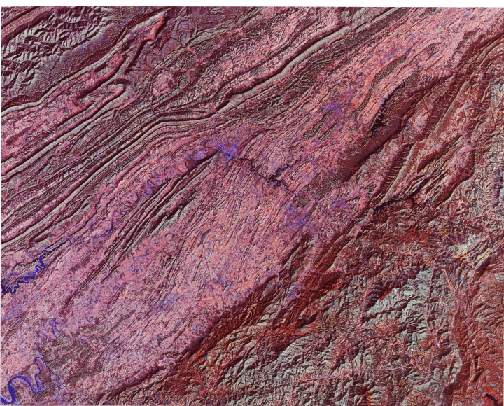Our odyssey proceeds west into the heart of the Appalachian fold belt that dominates the land forms of central Pennsyvania.
Most of the interior of this Landsat image depicts the Valley and Ridge province which runs from southernmost New York state to Alabama. Here, the sedimentary rocks that had compiled thicknesses up to 15250 m (50,000 ft) in parts of the geosynclinal deposition basin during the Paleozoic era were strongly folded into anticlines (uparches) and synclines (downbends) that were also shoved westward along thrust fault sheets. Erosion since the Appalachian Revolution has repeatedly sculpted ridges out of harder rocks (most commonly, sandstones) and valleys out of weaker rocks (such as shales). This results in a zig-zag pattern developed from folds that have also curved sharply as they pinch out, as seen in plan or horizontal perspective. The ridges, few of which are higher than 460 m (1500 ft), remain heavily forested but the valleys are mostly cleared for agriculture. Toward the lower right corner, a broader lowlands, the Great Valley of Pennsylvania - the northern extension of the Shenandoah Valley of Virginia - is underlain by shales and limestones of early Paleozoic age. The wide isolated ridge to the southeast is South Mountain/Catoctin Mountain, a complex of igneous-sedimentary-metamorphic rocks which ties up with similar rocks in the Blue Ridge in Virginia. The western (left) part of the image is occupied by the Appalachian Plateau that continues for several hundred kilometers into eastern Ohio. Its rocks are also Paleozoic sedimentary units that were not strongly folded (the compression effects die down in this region) and are still subhorizontal. However, the rock units were lifted en masse both during the orogeny and more recently to elevations high enough to foster deep local stream downcutting; the stream courses here are typical of the dendritic drainage pattern that develops on elevated terrain underlain by rocks of similar resistance to erosion.
The U.S. Appalachians extend into northern Georgia and Alabama, south of which they go "underground", being buried by sediments making up the Coastal Plains. (Actually, the general orogenic belt that includes the Appalachians of eastern North America extends westward across the Mississippi River through the Ouachita Mountains of Arkansas/Oklahoma before dying out in Texas; its northern end passes through Maine into Nova Scotia and Newfoundland and can be traced into mountain systems in the British Isles and Norway; the Atlas Mountains of northwestern Africa also are linked to the Appalachians; this once continuous belt was split at the end of the Paleozoic as the present continents broke apart with their tectonic plates then drifting in several directions.)
We will take a momentary "detour" in our flight to look at parts of the central and southern Appalachians. The first scene shows much of the Appalachian Belt from Pennsylvania through North Carolina as depicted in this Day-Vis (0.5 - 1.1 µm) image made by the Heat Capacity Mapping Radiometer on HCMM (see Section 9 for a description of this 1978 mission).
The swath width covered by the image is 715 km (445 miles); spatial resolution is 500 m (1615 ft). To get your bearings at this scale, locate Washington and Pittsburgh with the aid of an atlas.)The advantage of this overview scene is that it shows the entire central part of the Appalachian Mountains system in a single view. The fold belt of the Valley and Ridge Province is distinctive. At the northern end, in Pennsylvania, the zig-zag pattern described above is determined by the closed or pitching anticlines and synclines. This type of folding largely disappears to the south, being replaced by subparallel ridges separated by valleys. Note the sharp bend or "kink" in the belt near Roanoke, VA. This is, in part, fault-controlled. The Blue Ridge can be singled out because it lies to the east of the Shenandoah Valley in Virginia that continues as the Great Valley through Pennsylvania (both in light tones). The Piedmont to the southeast is not particularly obvious in this image; its terrain does not express well because of generally low relief. Its boundary with the Coastal Plains (The Fall Line, so-called because waterfalls form along some streams as they descend from harder Piedmont rocks to softer rocks coastwise) is also diffuse but generally its tone is darker than that of the Plains (more farming; less trees). The Cumberland Plateau west of the belt is much darker owing to heavy forestation. As that province grades into the Allegheny Plateau, the dissected morphology remains but forest cover diminishes.
The second is a Landsat subscene (covering about 100 km (63 miles) left-right) that contains parts of Tennessee, Virginia, and North Carolina. Kingsport, TN is the fuzzy blue patch in the center about 1/3 down; Douglas Lake on the French Broad River lies at the lower left corner.

A section of the Great Smoky Mountains north of Ashville occupies the lower right of the image. This is an assemblage of relatively homogeneous crystalline rocks that includes the Blue Ridge on their eastern side. Running diagonal through the image center is part of the Tennessee Valley, rolling hills underlain by more easily eroded limestones that tie into the Shenandoah Valley to the north. The Valley and Ridge is represented here by continuous folds of steeply dipping rocks that are also involved in the Pine Mountain thrust. The upper left is the beginning of the Cumberland Plateau, a southern extension of the Allegheny Plateau of Pennsylvania. Note both similarities and differences between this subscene and that you just looked at earlier. Here the South Mountain counterparts are much wider.
Code 935, Goddard Space Flight Center, NASA
Written by: Nicholas M. Short, Sr. email: nmshort@epix.net
and
Jon Robinson email: Jon.W.Robinson.1@gsfc.nasa.gov
Webmaster: Bill Dickinson Jr. email: rstwebmaster@gsti.com
Web Production: Christiane Robinson, Terri Ho and Nannette Fekete
Updated: 1999.03.15.